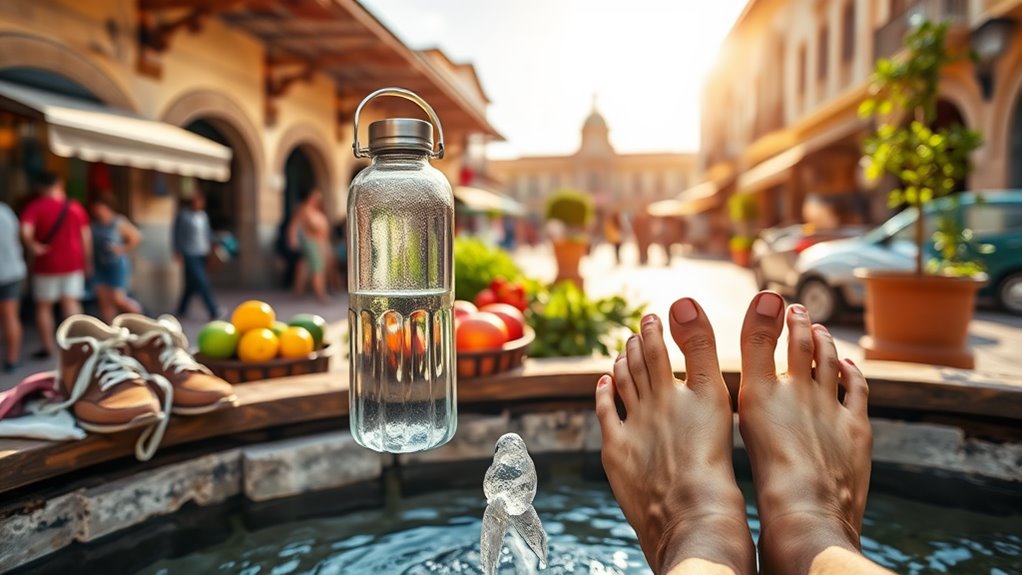To stop water retention while traveling, stay hydrated by drinking plenty of water and choosing low-sodium snacks like fresh fruits and veggies. Get moving by taking regular breaks to stretch or walk, which helps boost circulation. Incorporate natural diuretics like cucumbers and green tea into your diet. Consider wearing compression garments to reduce swelling. By following these tips, you’ll feel lighter and more comfortable on your journey, and you’ll discover even more helpful strategies.
Nomad Highlights
- Stay hydrated by drinking at least eight glasses of water daily to help flush out excess sodium and reduce water retention.
- Choose low-sodium snacks like fresh fruits and vegetables to prevent bloating and discomfort during your travels.
- Incorporate regular movement and stretching, taking walking breaks every hour to improve circulation and alleviate fluid buildup.
- Use natural diuretics such as cucumbers, watermelon, and herbal teas to help flush out excess fluids and reduce bloating.
- Wear compression garments like socks or leggings to enhance blood circulation and minimize swelling while traveling.
Stay Hydrated to Combat Retention

When you travel, it might seem counterintuitive, but staying hydrated is one of the best ways to combat water retention. Drinking plenty of water helps your body maintain its natural balance and flushes out excess sodium. Additionally, using a hydration backpack with a 2-liter capacity can make it easier to ensure you drink enough water on the go. Portable water purifiers, like the LifeStraw Personal Water Filter, provide an excellent solution for accessing clean water while traveling. Regular hydration enhances blood circulation, which is beneficial for reducing swelling and discomfort.
When you’re dehydrated, your body holds onto water, leading to swelling and discomfort. Aim to drink at least eight glasses a day, especially if you’re flying or spending time in hot climates. Having a portable water bottle with a filter ensures you have access to clean water, which is essential for hydration.
Carry a reusable water bottle to remind yourself to sip throughout the day. If plain water feels boring, infuse it with fruits or herbs for a revitalizing twist. Consider using a reusable water bottle with a filter to ensure you have access to clean water wherever you go.
Staying hydrated not only reduces water retention but also keeps your energy levels up, helping you feel your best while exploring new places.
Choose Your Snacks Wisely
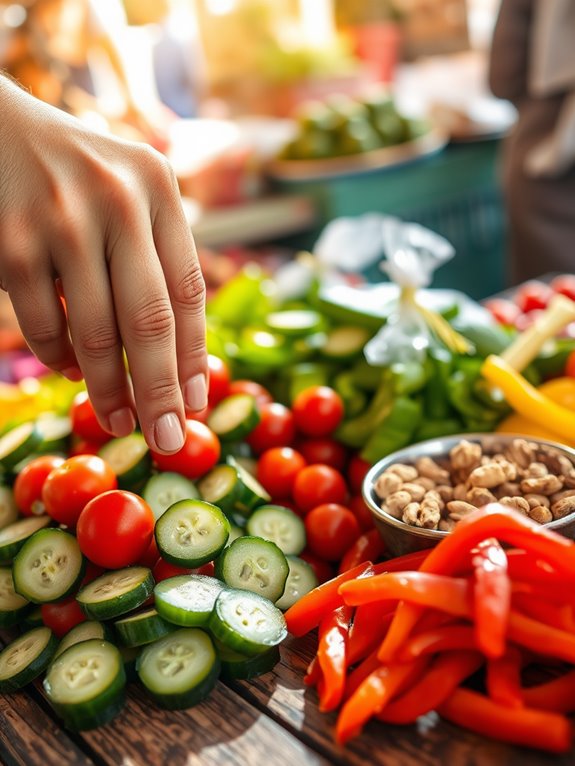
Choosing the right snacks while traveling can make a significant difference in managing water retention.
Opt for fresh fruits and vegetables, like apples, berries, and cucumbers, as they’re high in water content and low in sodium. Many fruit leather snacks are made with 100% natural ingredients and can be a nutritious option to keep you energized. Avoid processed snacks loaded with salt and preservatives, as these can increase bloating and water retention. Many vegetable crisps, for instance, are made from whole ingredients and often contain lower fat content compared to traditional snacks. Additionally, selecting unique products that cater to your dietary needs can enhance your travel experience. Reusable snack bags can help you pack these healthy options conveniently and promote eco-friendly practices while on the go.
Fresh fruits and veggies, like apples and cucumbers, are hydrating and low in sodium—perfect for avoiding bloating.
Instead, consider nuts or seeds in moderation for healthy fats and protein, which can help keep you satisfied. Yogurt is also a great option, providing probiotics that can support digestion.
If you crave something crunchy, try air-popped popcorn seasoned with herbs instead of salt. Additionally, incorporating high protein options can help replenish energy levels and maintain overall nutrition while on the go.
Incorporate Movement and Stretching
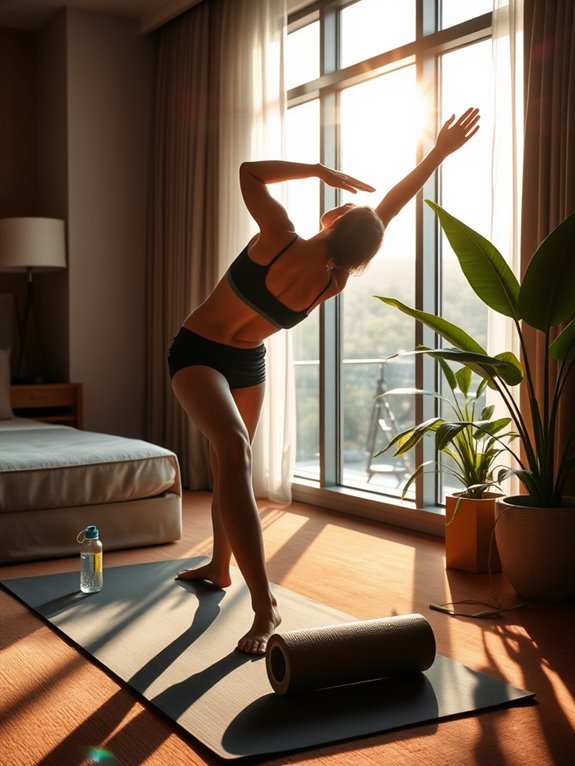
When you’re traveling, don’t underestimate the power of movement and stretching. Regular activity helps reduce water retention, so make it a point to stand up, stretch, and walk around whenever you can. Simple stretching techniques and walking breaks can provide the relief you need to feel your best on the go. Additionally, incorporating low-impact exercises like using exercise sliders can further enhance your circulation and alleviate fluid buildup. Exercise sliders are designed to engage core muscles effectively, promoting total body toning without joint strain. Utilizing resistance bands during your travels can also provide a convenient way to maintain your strength training routine and prevent muscle stiffness. These bands are designed for versatile training styles, making them ideal for various workouts while on the road. Remember that staying hydrated with proper hydration techniques can also play a crucial role in managing fluid retention while you travel.
Importance of Regular Movement
While you’re traveling, incorporating regular movement and stretching can greatly reduce water retention.
When you stay in one position for too long, your body tends to hold onto excess fluids, leading to swelling. To combat this, make it a point to get up and walk around every hour, whether you’re on a plane, train, or in a car. Additionally, maintaining proper posture while sitting can further enhance circulation and reduce the risk of swelling. Engaging in simple exercises like using balance boards can also improve your stability and promote movement while you travel. Furthermore, using collapsible foam rollers can provide effective muscle recovery and support your overall well-being.
Simple movements like ankle circles or leg lifts can stimulate circulation and help your body flush out excess water. Even short stretches can relieve tension and improve blood flow. Additionally, using compact foam rollers can enhance your muscle recovery and reduce tension while on the go, as they are designed to effectively enhance muscle recovery and promote blood circulation.
Consider scheduling breaks during your travel itinerary to prioritize movement. By keeping your body active, you’ll not only feel better but also minimize the discomfort of water retention.
Stretching Techniques for Relief
Incorporating effective stretching techniques into your travel routine can greatly alleviate water retention and enhance your overall comfort.
Regularly stretching while traveling helps improve circulation and reduces fluid buildup in your limbs. Here are some easy stretches you can do anywhere:
- Calf Stretch: Stand facing a wall, press your hands against it, and step one foot back to stretch your calf.
- Hamstring Stretch: Sit on the ground, extend one leg, and reach towards your toes.
- Quadriceps Stretch: Stand and pull one foot toward your buttocks, holding your ankle.
- Shoulder Stretch: Cross one arm across your body and gently pull it in with your opposite hand.
- Neck Stretch: Tilt your head to one side, feeling the stretch along your neck. Incorporating these stretches into your routine can lead to better health monitoring capabilities and supports effective recovery from long periods of inactivity, keeping you feeling light and refreshed! Additionally, maintaining real-time tracking of your activity levels can encourage you to stretch more frequently throughout your travels. Using digital timers can help you stay on track with your stretching routine and remind you to take breaks. Breathwork techniques can also help you promote relaxation and enhance your overall travel experience by reducing stress.
Incorporate Walking Breaks
Stretching alone can’t fully combat water retention during travel; you also need to keep moving. Incorporating walking breaks into your travel routine is essential.
Every hour, take 5 to 10 minutes to stroll around, whether you’re in an airport, train station, or hotel. This simple act promotes circulation and helps reduce fluid buildup in your legs. Consider using a lightweight design to enhance your comfort while moving. Additionally, carrying a portable utensil set can make it easier to enjoy healthy snacks on the go, further supporting your well-being. Regular movement can significantly improve blood circulation, reducing the likelihood of water retention during your travels. Staying hydrated is also important, as proper fluid balance can help mitigate water retention.
If you’re on a long flight or road trip, consider doing ankle circles or leg lifts in your seat to keep blood flowing.
Don’t underestimate the power of movement. Explore your destination on foot, and opt for stairs instead of elevators. Unique products for your everyday needs can also help enhance your travel experience and address water retention issues.
Limit Sodium Intake
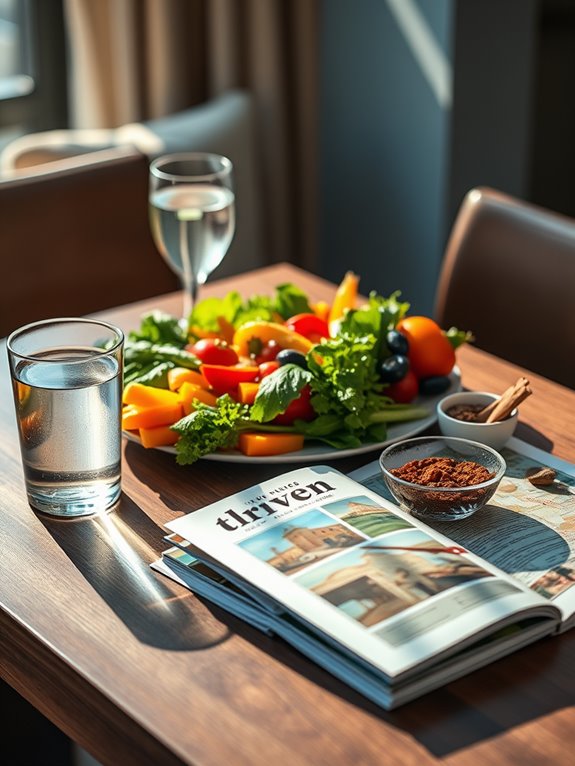
When you’re traveling, it’s easy to overlook sodium intake, but it can really affect water retention. Choose low-sodium foods, and make it a habit to read nutrition labels so you know what you’re consuming. Avoiding processed snacks can also help keep your sodium levels in check, making your trip more comfortable. Additionally, incorporating dried fruits into your snacks can offer a nutritious alternative while keeping sodium low. It’s also important to stay hydrated, as proper fit and comfort can prevent bloating and help your body regulate fluids more effectively. Incorporating unique products that cater to healthy eating can make it easier to maintain a low-sodium diet while traveling. Herbal teas like chamomile can also support relaxation and reduce stress, which may further help with overall comfort during your travels. Furthermore, staying mindful of your sodium intake while traveling can significantly aid in enhancing wellness and overall comfort.
Choose Low-Sodium Foods
Choosing low-sodium foods is essential for keeping water retention at bay while traveling. High sodium intake can lead to bloating and discomfort, so your best bet is to opt for fresh and wholesome options.
Here are some delicious low-sodium foods to take into account:
- Fresh fruits like apples, berries, and oranges
- Vegetables such as spinach, broccoli, and carrots
- Whole grains like quinoa, brown rice, and oats
- Lean proteins, including chicken, turkey, and fish
- Unsalted nuts and seeds for healthy snacks
Read Nutrition Labels
While opting for low-sodium foods is a great start, it’s equally important to read nutrition labels carefully.
You’ll be surprised how much sodium hides in everyday products. When you’re shopping, look for items that list sodium content, aiming for those with 140 mg or less per serving. That’ll help you make better choices and keep your sodium intake in check.
Don’t just focus on the total grams; pay attention to serving sizes too. A product might seem low in sodium, but if you eat more than one serving, it can add up quickly.
Avoid Processed Snacks
Many travelers unknowingly reach for processed snacks, unaware of the sodium lurking within. This excess sodium can lead to water retention, making you feel bloated and uncomfortable during your trip.
To keep your sodium intake in check, opt for healthier alternatives that satisfy your cravings without the added salt. Here are some great snack ideas:
- Fresh fruits like apples or bananas
- Raw vegetables such as carrots or bell peppers
- Nuts and seeds without added salt
- Whole grain crackers with hummus
- Yogurt or cottage cheese with fruit
Opt for Natural Diuretics
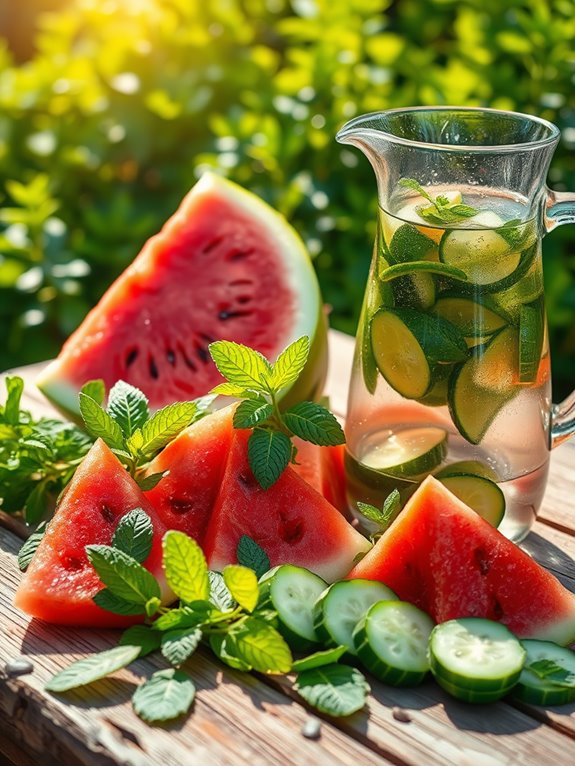
Natural diuretics can be a game-changer for managing water retention during your travels. Incorporating foods like cucumbers, watermelon, and celery into your meals can help flush out excess fluids. These natural options contain high water content and essential nutrients, making them perfect for hydration while combating bloating.
Herbal teas, such as dandelion or green tea, also work wonders by promoting urination and reducing water retention. You can easily pack some tea bags for a revitalizing drink on the go.
Additionally, consider adding lemon to your water; it not only tastes great but can also enhance your body’s natural diuretic properties. By choosing these natural options, you’ll feel lighter and more comfortable throughout your trip.
Wear Compression Garments
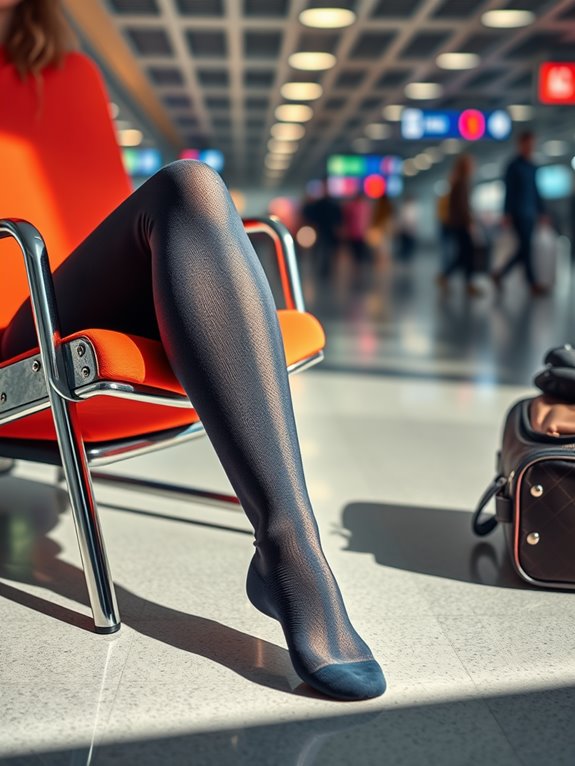
Wearing compression garments can considerably reduce water retention during your travels.
These specially designed pieces of clothing apply pressure to your legs and other areas, promoting better blood circulation and helping to prevent swelling.
Whether you’re on a long flight or a road trip, consider including compression garments in your travel essentials.
- Choose compression socks or stockings for better circulation.
- Opt for compression sleeves for arms and calves.
- Look for leggings with built-in compression features.
- Don’t forget a compression wrap for swollen areas.
- Confirm a proper fit to maximize benefits.
Frequently Asked Questions
Can Dehydration Cause Water Retention While Traveling?
Yes, dehydration can lead to water retention. When your body senses a lack of water, it holds onto fluids to prevent further loss. Staying hydrated helps maintain balance and reduces the likelihood of retaining excess water.
What Are Some Examples of Natural Diuretics?
Naturally, you’ll find fantastic fluid-flushers like dandelion, green tea, and asparagus. These natural diuretics help you shed excess water. Incorporating them into your diet can promote proper hydration and support overall well-being.
How Does Altitude Affect Water Retention?
Altitude can increase water retention due to lower oxygen levels. Your body retains fluid to compensate for reduced air pressure, leading to swelling. Staying hydrated and adjusting gradually can help minimize these effects while acclimatizing.
Are There Specific Foods to Avoid for Water Retention?
To reduce water retention, you should avoid salty foods, processed snacks, and sugary items. These can lead to increased sodium levels and inflammation, causing your body to hold onto excess water. Focus on whole, fresh foods instead.
Should I Consult a Doctor Before Taking Diuretics?
Yes, you should consult a doctor before taking diuretics. They can assess your specific condition, recommend appropriate dosages, and monitor potential side effects. Self-medicating can lead to serious health complications, so it’s best to get professional advice.
Conclusion
To wrap things up, tackling water retention while traveling is all about staying smart and proactive. Did you know that nearly 60% of travelers experience some form of swelling during their trips? By staying hydrated, choosing the right snacks, moving around, limiting sodium, using natural diuretics, and wearing compression garments, you can greatly reduce that bloated feeling. So, next time you hit the road, keep these tips in mind for a more comfortable journey!

